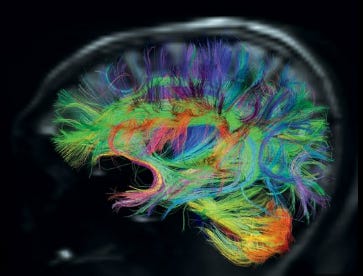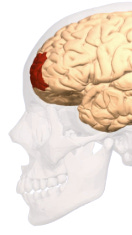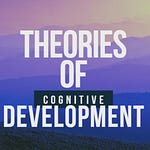The human brain is particularly attuned toward self-reflection during times of quiet contemplation. Several studies have found (Buckner & Carroll, 2007; Moran, Kelley, & Heatherton, 2013; Spreng et al., 2009) that people engage in self-referential processing when they are not attending to the outside world. This is because the brain engages in a specific neuronal activation, which occurs when the brain is at rest, called the default network (Damoiseaux et al., 2006). The brain's resting state can be thought of as what the brain is doing when it is not doing anything, and is sometimes called the default mode.
Revolutionary Developments in Default Mode Network Research
Since its discovery by Marcus Raichle and colleagues in 2001, the default mode network (DMN) has revolutionized our understanding of the workings of the human brain. Recent comprehensive reviews examining the past 20 years of research reveal that the DMN is far more complex and significant than originally understood. Rather than being simply a "task-negative network" that deactivates during goal-directed behavior, the DMN has emerged as a central component of human consciousness and cognition.
A landmark 2023 review by leading neuroscientist Vinod Menon demonstrates that the DMN integrates and broadcasts memory, language, and semantic representations to create a coherent "internal narrative" reflecting our individual experiences. This narrative is central to the construction of a sense of self, shapes how we perceive ourselves and interact with others, may have ontogenetic origins in self-directed speech during childhood, and forms a vital component of human consciousness.
The Expanding Architecture of Self-Referential Processing
What is interesting about the default mode is that the region of peak activation during rest is in an area of the medial prefrontal cortex (MPFC) called Brodmann's area 10 (BA 10), which has been found to be engaged in self-referential processing (Denny et al., 2012). The MPFC is the largest of prefrontal regions in the brain (Öngür et al., 2003), and has been found to activate when people reflect on their emotions (Ochsner et al., 2004), think about their personality (Kelley et al., 2002), or their past and future (Spreng & Grady, 2010; Spreng et al., 2009). For this reason, the MPFC/BA 10 has important connections to metacognition and self-reflection.
Recent breakthrough research in 2023 has refined our understanding of how the self-concept is represented in the medial prefrontal cortex. Using advanced neuroimaging techniques including searchlight representational similarity analysis, researchers discovered that the importance of attributes to self-identity was specifically represented in the mPFC, whereas mPFC activation was unrelated to both self-descriptiveness of attributes and importance of attributes to a friend's self-identity. This finding suggests that the mPFC conceptualizes the self-concept specifically in terms of self-importance rather than general self-description.
Furthermore, recent evidence from a population brain-imaging study of 10,000 UK Biobank participants reveals that each DMN node can be decomposed into subregions with complementary structural and functional properties. The close proximity of subnodes that propagate hippocampal space-time outputs and subnodes that describe the global network architecture may enable default functions, such as autobiographical recall or internally-oriented thinking.
The DMN as Core Consciousness
Recent theoretical advances propose that the DMN serves as the hypothetical "core of consciousness." The DMN comprises cortical regions that are maximally distant from primary sensory and motor cortex, a topological location that facilitates the expression of stimulus-independent aspects of cognition. The DMN has an aspect of itself that is cut off from the rest of the environment, which does not receive sensory input from the rest of the brain. The posterior DMN contains a model of the activity of the brain itself, an internal simulation of the self within the self, which is critical for our capacity to reflect on ourselves.
Emerging research using transcranial focused ultrasound stimulation (TFUS) shows that we can now stimulate the posterior cingulate cortex with sound beams, reducing functional connectivity and creating changes in subjective self-experience akin to meditative states, such as altered sense of time and ego, and changes in remembering. These advances suggest that we may soon be able to precisely modulate consciousness and self-awareness through targeted neuromodulation.
The Complex Relationship Between Self and Social Processing
However, along with demonstrating strong processing reactions during self-reflective tasks, the MPFC region, ironically, has also shown activation while processing social information (Moran et al., 2013). These regions are considered by some researchers to be part of the "social brain" (Heatherton, 2011; Lewis et al., 2011). There is a strong neuro-physical relationship between introspective self-reflective thought and a tendency to connect introspections to social relationships (Meyer & Lieberman, 2018).

Contemporary research has revealed that the DMN is functionally heterogeneous, comprising regions engaged by memory, social cognition and planning—processes relevant to mind-wandering content. The DMN includes specialized regions such as the dorsal medial prefrontal cortex (dmPFC) involved in social directed thought such as determining or inferring the purpose of others' actions, and the temporoparietal junction (TPJ) which reflects on beliefs about others, also known as theory of mind.
Recent studies demonstrate that individual variation in task performance modulates the functional organization of the DMN: poor external engagement is linked to stronger coupling between medial and dorsal subsystems, while decoupling of the core from the cerebellum predicts reports of detailed memory retrieval. This suggests that the DMN supports experiences that span from stimulus-independent thought to detailed episodic recollection.
Mind Wandering and the Wandering Mind
Modern neuroscience has revealed that the default mode network is active during passive rest and mind-wandering which usually involves thinking about others, thinking about one's self, remembering the past, and envisioning the future rather than the task being performed. However, recent work has challenged a simple mapping between the default mode network and mind-wandering, given that the system is important in maintaining detailed representations of task information during working memory encoding.
The DMN shows increased activity during mind-wandering episodes and has been associated with mind-wandering characteristics such as semantic processing, task-unrelated thoughts, unconstrained thoughts, and self-related processing. Recent research from 2025 demonstrates that resting-state BOLD temporal variability of the default mode network predicts spontaneous mind wandering, which is negatively associated with mindfulness skills.
Contemporary accounts of mind-wandering suggest that it is best understood as the combination of different component processes: the decoupling of attention from perceptual input that allows cognition to become independent of external events, and the retrieval of episodic and semantic knowledge which provides the mnemonic representations upon which internal thought is based.
Clinical Implications and Therapeutic Applications
Alterations of the DMN have been linked to many psychological disorders, including depression, anxiety, schizophrenia, borderline personality disorder, and narcissistic personality disorders. Understanding how DMN functional connectivity disruptions can be measured and corrected with therapeutics to restore healthy connectivity represents a compelling avenue for future research.
While medications and therapy affect DMN function, we're entering an era of more targeted neuromodulation. Functional brain imaging and mapping technologies will likely provide personalized treatment—analyzing fMRI to develop personalized transcranial magnetic stimulation (TMS) protocols. Deep brain stimulation via implanted electrodes would allow for additional targeting and maintaining of various ongoing stimulation protocols.

The Built-in Tendency for Introspection
It may be that during quiet times, when we disengage from our subjective thinking, the natural tendency of our default mode is to self-reflect on ourselves and our social relationships. So it may be that we are built to introspect when we are not focused on our external environment.
Recent research confirms this built-in tendency by showing that greater default engagement in MPFC/BA 10 during momentary breaks preferentially facilitates task performance on subsequent self-reflection trials on a moment-to-moment basis. These results suggest that reflexively engaging MPFC/BA 10 by default may nudge self-referential thinking, perhaps explaining why humans think about themselves so readily.
The DMN exhibits the highest overlap in its structural and functional connectivity, which suggests that the structural architecture of the brain may be built in such a way that this particular network is activated by default. This discovery of the DMN has revolutionized our understanding that the brain is constantly active with a high level of background activity even when we are not engaged in focused mental work, with energy consumption increasing by less than 5% during focused mental tasks.
Future Directions and Implications
As we continue to unravel the mysteries of the default mode network, we gain deeper insights into the fundamental nature of human consciousness, self-awareness, and social cognition. The convergence of evidence from 20 years of research suggests that the DMN serves as the neural foundation for our sense of self and our ability to navigate complex social relationships.
The development of sophisticated neuromodulation techniques, combined with advanced neuroimaging capabilities, offers unprecedented opportunities to understand and potentially enhance human consciousness and self-reflection. As our understanding of the DMN continues to evolve, we move closer to answering fundamental questions about what makes us uniquely human and how the brain creates the rich inner world of human experience.














